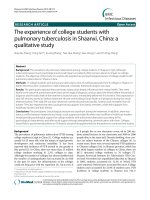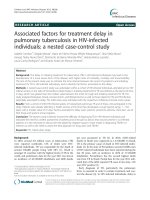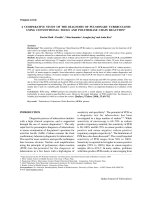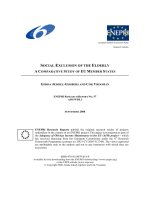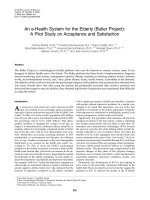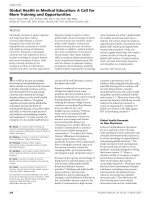Sputum cellularity in pulmonary tuberculosis: A comparative study between HIV-positive and -negative individuals pptx
Bạn đang xem bản rút gọn của tài liệu. Xem và tải ngay bản đầy đủ của tài liệu tại đây (93.86 KB, 7 trang )
Journal of AIDS and HIV Research Vol. 2(2) pp. 017 – 023, February, 2010
Available online
©2010 Academic Journals
Full Length Research Paper
Sputum cellularity in pulmonary tuberculosis: A
comparative study between HIV-positive and -negative
individuals
Rosemeri Maurici da Silva
1
*, Paula Stocco
1
, Maria Luiza Bazzo
2
and
Mariana Chagas
2
1
Universidade do Sul de Santa Catarina– Brasil.
2
Universidade Federal de Santa Catarina – Brasil.
Accepted 15 December, 2009
To compare sputum cellularity between HIV-positive and -negative individuals with pulmonary
tuberculosis. A cross-sectional study was conducted in patients with pulmonary tuberculosis. Sputum
samples were collected and processed within two hours after collection. The absolute number of
squamous cells of a total of 400 cells was counted, as well as the absolute number (× 10
6
cells/ml) and
percentage of eosinophils, lymphocytes, macrophages and neutrophils and total cellularity and viability
were determined. Comparisons of the means of each cell type were held in a significance level of 95%
(p < 0.05). Pearson’s correlation coefficient between the identified cell types was calculated. Results:
Assessment was performed in a cohort of 40 subjects, mean age 40 years, 77.5% male, 70% Caucasian,
40% HIV-positive (mean age 35.9 years). Mean percentage viability in the samples was 56.1%. The
average value of squamous cells was 58.8. Mean percentages of cells were: 33.7% neutrophils, 1.7%
eosinophils, 50.7%, macrophages and 12.3% lymphocytes. The average total cell count was 1.9 x 10
6
cells/ml. The average CD4
+
T-cell count in HIV-positive was 95.4 cells/mm
3
. Association of radiological
patterns was present in 72.5% of cases. Pearson’s correlation coefficient was 0.08 (p < 0.01) between
absolute counts of eosinophils and lymphocytes, eosinophils and macrophages and macrophages and
neutrophils. Inverse relationship was observed between the percentage of macrophages and
neutrophils. There was no statistically significant difference between cell count of HIV-positive and -
negative individuals.
Key words: Sputum, tuberculosis, HIV.
INTRODUCTION
Tuberculosis is a chronic infectious disease caused by
Mycobacterium tuberculosis bacillus (Koch bacillus),
whose main characteristic is the preference for lung
parenchyma and transmission from person to person,
which occurs by inhalation of microorganism infected
particles (Brasil. Ministério da Saúde. Coordenação
Nacional de DST/AIDS, 1999).
With the advent of the acquired immunodeficiency
syndrome (AIDS), recognized in 1981, a profound impact
*Corresponding author. Email:
on the global problem of tuberculosis occurred, which
changed its epidemiology and particularly, its control
became more difficult. Tuberculosis kills approximately
two million people annually and measures to control this
disease are vulnerable to early diagnosis, resistance to
drugs used for its treatment as well as the socioeconomic
conditions of populations at risk (Brasil. Ministério da
Saúde. Coordenação Nacional de DST/AIDS, 1999;
Duncan et al., 1996).
M. tuberculosis is a facultative intracellular bacterium;
its replication process and the way it is carried through
the host during the course of infection are not completely
defined. It is believed that macrophages are the main
018 J. AIDS HIV Res.
cells in which the M. tuberculosis is found in vivo,
although dendritic cells may also be infected. M.
tuberculosis is found in extracellular environment in the
stages of lung cavitation. It is not clear how the bacterium
adapts specifically to the lungs at the expense of other
tissues and how the bacterium survives and grows in
phagocytes of macrophages and other cells (Brasil.
Ministério da Saúde. Fundação Nacional de Saúde,
2002).
Human immunodeficiency virus (HIV) infection is a
leading risk factor for the development of disease in
individuals previously infected by the bacillus. While the
chance of an infection progressing to TB disease in
immunocompetent individuals is 10% over their life span,
in HIV-infected individuals that is likely to be 8 to 10%
every year. Moreover, it is one of the first and major
complications among HIV-infected individuals, appearing
before other common infections (Brasil. Ministério da
Saúde. Fundação Nacional de Saúde, 2002; Davis et al.,
1993).
In 1999, 10.7 million people co-infected with TB/HIV
were identified, which represents 0.18% of the world
population. In Brazil, of the 40.7 million infected with
tuberculosis, about 300 thousand were co-infected with
HIV (Brasil. Ministério da Saúde. Coordenação Nacional
de DST/AIDS, 1999).
TB remains a common disease and
is an important differential diagnosis when lung
secretions are sent for laboratory examination. Currently,
there is little information on sputum cytology of patients
with pulmonary tuberculosis (Brasil. Ministério da Saúde.
Fundação Nacional de Saúde, 2002).
Radiological alterations of patients with TB/HIV co-
infection depend on peripheral blood CD4
+
T-cell count.
When the CD4 count is below 200 cells/mm
3
, most
manifestations of TB are atypical. At the beginning of HIV
infection, or when the CD4
+
T-cell count is above 200
cells/mm
3
, tuberculosis presents a radiologic form similar
to that in immunocompetent patients, with typical
reactivation pattern and with areas of alveolar
consolidation at the apex, posterior segments of the
upper lobes and superior segments of the lower lobes,
often associated with cavitation (Boiselle et al., 2002;
Haramati and Jenny-Avital, 1998; Shah et al., 1997;
Keiper et al., 1995; Post et al., 1995; Naidich and
McGuinness, 1991; Pitchenik and Rubinson, 1985;
Pizzichini et al., 1996). In patients who are in advanced
stages of HIV infection, with CD4
+
T-cell count below 200
cells/mm
3
, significant radiographic differences are
documented, compared to immunocompetent patients,
such as mediastinal and/or hilar lymph nodes and in
some cases, no radiographic alterations (Haramati and
Jenny-Avital, 1998; Shah et al., 1997; Keiper et al., 1995;
Naidich and McGuinness, 1991; Pitchenik and Rubinson,
1985). Tuberculosis infection in immunocompetent
individuals begins primarily as a non-specific
inflammatory reaction, progressing to a typical
granulomatous reaction that limits M. tuberculosis spread.
In immunosuppressed individuals with low CD4
+
T-cell
count, granuloma formation does not occur (Botasso et
al., 2007).
Although primarily cellular immunity is involved, other
defects are also identified and play important role in the
morbidity of HIV infection. T lymphocytes are critical for
the activation of B lymphocytes and subsequent
production of immunoglobulins, which is compromised by
the primary disorder of cellular immunity. These systemic
alterations are concomitant to the local alterations.
Subsystems of different T lymphocytes are involved in
immune response against M. tuberculosis. Interferon-
gamma production by cells appears to be fundamental for
disease control. Th1 cytokine response type is
predominant in patients with mild and moderate forms of
pulmonary tuberculosis, while Th2 type cytokine
production prevails in more severe disease. Studies show
that patients with cavitary tuberculosis revealed the
presence of IL-4 produced by Th2 system. In contrast,
Th1-type cytokines are found in cases of non-cavitary
disease (Botasso et al., 2007).
The macrophages present CD4 antigens and can be
directly infected by HIV. In these cases the process of
chemotaxis is also disturbed, resulting in decrease or
even absence of granulomatous reaction. In addition,
there is a decrease in chemotaxis of polymorphonuclear
cells (Davis et al., 1993). Therefore, alterations in sputum
cellularity occur concurrently to alterations in peripheral
blood CD4
+
T-cells, reflecting on the manifestations of
respiratory diseases in this specific group of patients,
both in the radiological manifestations and in the tissue
reactions where there is no granuloma formation due to
decreased immunity (Davis et al., 1993).
During a recent infection with HIV, when the function of
the immune system is relatively intact, sputum examina-
tion of smear-positive for tuberculosis predominates. In
contrast, patients with advanced HIV infection with
significant immunosuppression often present negative
sputum examination results and disease disseminates.
Although the correlation between the significance of
sputum examination and decrease in the immune system
function (drop in the number of CD4
+
T-cells) in HIV-
positive patients with pulmonary tuberculosis is well do-
cumented, the relationship between sputum examination
and local immune response in the lungs is not clear
(Mwandumba et al., 2008).
The study carried out by Belda and collaborators found
the following results for sputum cellularity in healthy
patients: cell viability was 89.7%, the proportion of
eosinophils was 1.1%, neutrophils 64%, macrophages
86.1%, lymphocytes 2.6%, metachromatic cells 0.04%
and epithelial cells 4.4%. Female gender and atopy are
associated with a significant elevation of eosinophils,
male-to-female ratio was 0.3% and between atopic and
non-atopic patients was 0.4% (Belda et al., 2000).
There is little information on sputum cytology in
pulmonary tuberculosis. A study carried out by Tani and
collaborators showed that alveolar macrophages are
always present, while neutrophils are present in 97.9% of
samples, usually in large numbers. Lymphocytes were
found in 84.9% and eosinophils in 8.9%, usually in small
numbers. Epithelial cells were found in 56.1% of sam-
ples, usually appearing in groups with oval and elongated
nucleus, along with a large vacuolated cytoplasm.
Multinucleate giant cells were present in 40% of samples,
usually in small numbers and often associated with
epithelial cells. Respiratory epithelium cells showed
changes in 20% of samples, which include grouped
columnar cells with hyperchromatic nucleus. Squamous
metaplasia was observed in 19% of samples (Tani et al.,
1987).
This study was carried out to compare sputum
cellularity between HIV-positive and HIV-negative
individuals with pulmonary tuberculosis.
MATERIALS AND METHODS
A cross-sectional study was performed at Hospital Nereu Ramos, in
Florianopolis, Santa Catarina, in which all patients over 14 years
with pulmonary tuberculosis admitted between November 2008 and
February 2009 were analyzed. Patients who had pulmonary
comorbidity were excluded from the study, as well as those who
refused to sign the Term of Free and Informed Consent, or those
who were unable to produce sputum spontaneously. HIV-infected
patients were considered those who had positive serology for HIV,
patients with pulmonary tuberculosis and those with identification of
M. tuberculosis in respiratory samples (bronchoalveolar lavage
and/or lung and pleural biopsies).
Chest x-rays were classified according to alteration patterns in
alveolar consolidation, interstitial, pleural effusion, mass, nodule,
cavitation, mediastinal and/or hilar lymph nodes and their
associations. Siemens X-ray device was used for postero-anterior
and lateral chest radiography, using 120 Kv and 3 to 6 mAs.
Sputum samples were collected at morning and before breakfast.
The sputum samples were processed within two hours after
collection. An aliquot of sputum was treated with approximately 4
volumes of DTT (dithiothreitol) plus 4 volumes of PBS (phosphate
buffer) and filtered after homogenization. Twenty microlitres of
filtrate were mixed with 20 µl of 4% trypan blue. This mixture was
placed in a Neubauer chamber where the absolute number of cells
(x 10
6
cells/ml) and the number of live and dead cells in a clear field
microscope with a 400x magnification were counted. The
percentage of live and dead cells was resulting from the equation:
(number of live cells/total number of cells) × 100. The presence of
alveolar macrophages was determined by differential leukocyte
counting in the filtrate of the sputum sample. The filtrates were
concentrated by citospin technique and the slides were stained by
the May-Grünwald/Giemsa method and viewed in clear field
microscope with a 1000x magnification. The number of squamous
epithelial cells in a total of 400 cells and the number of eosinophils,
lymphocytes, macrophages and neutrophils on differential count of
100 cells was determined. The absolute number and percentage of
each cell type was calculated based on the total number of cells
(Pizzichini et al., 1996; Botasso et al., 2007).
Each participant was registered in a form of inclusion and agreed
to participate by signing a Term of Free and Informed Consent.
Database development and statistical analysis were performed
using SPSS version 16.0
®
software. Data were summarized as per-
centage or mean, as indicated, and comparisons of means of each
cell type were performed by Student’s t-test, with a significance
Maurici da Silva et al. 19
level at 95% (p < 0.05). The Pearson’s correlation coefficient for the
identified cell types was also calculated.
The research project was submitted to the Ethics Committee and
Human Research at Unisul and approved under code number
09.005.4.01.III.
RESULTS
Forty consecutive individuals, 31 (77.5%) male, were
evaluated. Regarding ethnicity, 28 (70%) were
Caucasian. Mean age was 40 years (SD±12), ranging
from 22 to 69 years.
Of the participants, 16 (40%) were HIV positive and 24
(60%) were negative. Mean age of HIV-positive
individuals was 35.9 years (SD±7.16) and mean age of
HIV-negative individuals was 42.8 years (SD±13.8).
There was no statistically significant difference between
mean age of HIV-positive and HIV-negative individuals (p
0.75).
Mean percentage of viability in sputum samples was
56.1% (SD±31%). The average value of squamous cells
in a total of 400 cells assessed was 58.8 (SD±157.7).
Mean value of cells (× 106 cells/ml±SD) and mean
percentage (±SD) in sputum samples were: neutrophils
0.9 ± 1.4 (33.7 ± 3.2%), eosinophils 0.03 ± 0.08 (1.7 ±
2.8%), macrophages 0.8 ± 1.3 (50.7 ± 20.3%),
lymphocytes 0.2 ± 0.3 (12.3 ± 11.8%) and total cells 1.9 ±
2.5.
Mean CD4
+
T-cell count in HIV-positive individuals was
95.4 ± 62.8 cells/mm
3
, with a minimum of 13 and
maximum of 224 cells/mm
3
.
Mean value and percentage of cells in sputum samples
of HIV-positive and HIV-negative individuals are shown in
Table 1.
There was a statistically significant difference in
absolute counts of squamous cells when compared
between HIV-positive and -negative individuals (p 0.028).
There was no statistically significant difference between
the other cell counts when compared between HIV-
positive and -negative individuals (p > 0.05).
With regard to radiological alterations, the association
between patterns was present in 29 (72.5%) of cases (10
HIV-positive and 19 HIV-negative), alveolar injury in 32
(80%) of cases (13 HIV-positive and 19-negative),
interstitial lesion in 15 (37.5%) of cases (8 HIV-positive
and 7 -negative), cavitation in 10 (25%) of cases (4 HIV-
positive and 6 -negative), pleural effusion in 9 (22, 5%) of
cases (3 HIV-positive and 6 -negative), atelectasis in 4
(10%) of cases (1 HIV-positive and 3 -negative), nodules
in 3 (7.5%) of cases (HIV-negative) and pneumothorax,
adenomegaly and mass in 1 (2.5%) of cases,
respectively (HIV-negative).
The average values and percentage of cells in sputum
samples in accordance with the radiological alterations
are shown in Table 2.
Pearson’s correlation coefficient between the cell
values in sputum samples is shown in Table 3.
020 J. AIDS HIV Res.
Table 1. Mean value and percentage of cells in sputum samples of HIV-positive and -negative individuals.
HIV-positive HIV-negative
n (±DP) % (±DP) n (±DP) % (±DP)
Viability - 54.4 ± 33.5 - 57.2 ± 29.9
Squamous Cells*
(in 400 cells)
116.1 ± 241.1 - 20.5 ± 21.4 -
Neutrophils
#
1.1 ± 1.7 34.3 ± 28 0.7 ± 1.1 33.4 ± 20.1
Eosinophils
#
0.03 ± 0.1 2.2 ± 3.6 0.04 ± 0.1 1.4 ± 2
Macrophages
#
0.6 ± 1.2 50.6 ± 28.4 0.9 ± 1.3 50.8 ± 13.1
Lymphocytes
#
0.2 ± 0.3 10.6 ± 9.6 0.2 ± 0.3 13.4 ± 13.1
Total Cells
#
1.9 ± 2.8 - 1.8 ± 2.4 -
* p 0.028
#
x 10
6
/ml.
Table 2. Mean value and percentage of cells in sputum samples according to the radiological patterns.
Viability Squamous cells Neutrophils Eosinophils Macrophages Lymphocytes Total cells
%(±DP) n(±DP) n(±DP) %(±DP) n(±DP) %(±DP) n(±DP) %(±DP) n(±DP) %(±DP) n(±DP)
Yes 54.4 ± 30.2 60.2 ± 182.3 1 ± 1.5 35.4 ± 24.5 0.03 ± 0.1 1.9 ± 3.1 0.8 ± 1.4 49.8 ± 19.7 0.2 ± 0.3 11.7 ± 10.1 2 ± 2.8 Association
Standards
No 60.4 ± 34.3 55 ± 62.6 0.7 ± 1 29.4 ± 20 0.03 ± 0.1 1.3 ± 1.6 0.7 ± 1.1 53 ± 22.5 0.2 ± 0.3 13.9 ± 15.8 1.6 ± 1.9
Yes 53.8 ± 31.2 59.3 ± 174 1± 1.4 34 ± 23.3 0.03 ± 0.1 1.7 ± 3 0.9 ± 1.4 51.3 ± 19.9 0.2 ± 0.3 11.7 ± 10.7 2.1 ± 2.7 Alveolar
No 65 ± 30.6 56.9 ± 66.7 0.4 ± 1 32.8 ± 24.6 0.03 ± 0.1 1.6 ± 1.8 0.2 ± 0.2 48.3 ± 23.2 0.2 ± 0.3 14.8 ± 15.9 0.8 ± 1.3
Yes 57.8 ± 36.5 122.9 ± 246.7* 0.9 ± 1.7 33.5 ± 23.6 0.03 ± 0.1 3.1 ± 3.7*
0.5 ± 1 46.5 ± 22.1 0.2 ± 0.3 15.6 ± 11.7 1.6 ± 2.7 Interstitial
No 55 ± 28 20.3 ± 28.5* 0.9 ± 1.1 33.9 ± 23.5 0.03 ± 0.1 0.8 ± 1.5*
1 ± 1.4 53.2 ± 19.2 0.1 ± 0.3 10.3 ± 11.6 2 ± 2.5
Yes 47.4 ± 23 33.6 ± 58 0.7 ± 1.3 30.9 ± 24.6 0.03 ± 0.1 2 ± 4.4 0.8 ± 1.4 57.5 ± 17.3 0.1 ± 0.1 11.3 ± 10.3 1.7 ± 2.5 Cavitation
No 59 ± 33.1 67.2 ± 179.2 0.9 ± 1.4 34.7 ± 23.1 0.04 ± 0.1 1.6 ± 2 0.8 ± 1.2 48.4 ± 21 0.2 ± 0.3 12.7 ± 12.4 1.9 ± 2.6
Yes 69.6 ± 19.8 12.3 ± 16.5 1.2 ± 1.2 39.6 ± 31.1 0.1 ± 0.1 1.3 ± 1.9 1.1 ± 1.5 47.3 ± 25.4 0.2 ± 0.4 5.2 ± 4.8* 2.5 ± 2.7 Pleural
effusion
No 52.1 ± 32.8 72.3 ± 177.3 0.8 ± 1.4 32.1 ± 20.7 0.03 ± 0.1 1.8 ± 3 0.7 ± 1.2 51.7 ± 19 0.2 ± 0.3 14.4 ± 12.4* 1.7 ± 2.5
Yes 69 ± 4.4 17.5 ± 31.1 1.1 ± 1.9 39 ± 30.1 0.0002 ± 0.0003 0.5 ± 1 0.5 ± 0.4 49.5 ± 27.5 0.1 ± 0.2 8.8± 11.5 1.8 ± 2.3 Atelectasis
No 54.6 ± 32.4 63.4 ± 165.6 0.9 ± 1.3 33.2 ± 22.8 0.04 ± 0.1 1.8 ± 2.9 0.8 ± 1.3 50.8 ± 19.8 0.2 ± 0.3 12.7 ± 11.9 1.9 ± 2.6
Yes 37 ± 34 3.7 ± 5.5 1.3 ± 2.3 39 ± 39 0 ±0 0 ± 0 0.4 ± 0.5 42.3 ± 20.2 0.1 ± 0.1 18.3 ± 23.3 1.8 ± 2.9 Nodule
No 57.6 ± 30.7 63.2 ± 163.3 0.8 ± 1.3 33.3 ± 22.3 0.04 ± 0.1 1.8 ± 2.8 0.8 ± 1.3 51.4 ± 20.4 0.2 ± 0.3 11.8 ± 10.8 1.9 ± 2.6
Yes 67 1 4* 79* 0 0 1 19 0.1 2 5.1 Pneumothorax
No 55.8 ± 31.4 60.3 ± 159.5 0.8 ± 1.3* 32.6 ± 22.3* 0.03 ± 0.1 1.7 ± 2.8 0.8 ± 1.3 51.5 ± 19.9 0.2 ± 0.3 12.6 ± 11.8 1.8 ± 2.5
Yes 67 1 4* 79* 0 0 1 19 0.1 2 5.1* Adenomegaly
No 55.8 ± 31.4 60.3 ± 159.5 0.8 ± 1.3* 32.6 ± 22.3* 0.03 ± 0.1 1.7 ± 2.8 0.8 ± 1.3 51.5 ± 19.9 0.2 ± 0.3 12.6 ± 11.8 1.8 ± 2.5*
* p < 0.05.
Maurici da Silva et al. 021
Table 3. Pearson’s correlation coefficient between mean value and percentage of cells in sputum samples.
Viability
(%)
Squamous
cells (n)
Neutrophils
(n)
Neutrophils
(%)
Eosinophils
(n)
Eosinophils
(%)
Macrophages
(n)
Macrophages
(%)
Lymphocytes
(n)
Lymphocytes
(%)
Total
cells
Viabilidade (%) 1 -0.2 0.2 0.1 0.1 0.2 0.02 -0.5** 0.3 0.01 0.2
Squamous cells (n) -0.2 1 -0.1 -0.2 -0.02 0.2 -0.2 0.1 -0.03 0.2 -0.2
Neutrophils (n) 0.2 -0.1 1 0.6** 0.4* -0.04 0.6** -0.5** 0.4* -0.2 0.9**
Neutrophils (%) 0.2 -0.2 0.6** 1 0.1 -0.3 0.1 -0.7** 0.2 -0.3 0.4*
Eosinophils (n) 0.1 -0.02 0.4* 0.1 1 0.4* 0.5** -0.3 0.8** 0.1 0.6**
Eosinophils (%) 0.2 0.2 -0.04 -0.3 0.4* 1 -0.01 -0.1 0.2 0.2 0.02
Macrophages (n) 0.02 -0.2 0.6** 0.1 0.5** -0.01 1 0.1 0.3* -0.3 0.9**
Macrophages % -0.5 0.1 -0.5** -0.7** -0.3 -0.1 0.1 1 -0.5** -0.2 -0.3*
Lymphocytes n 0.3 -0.03 0.4* 0.2 0.8** 0.2 0.3* -0.5** 1 0.4* 0.5**
Lymphocytes % 0.01 0.2 -0.2 -0.3 0.1 0.2 -0.3 -0.2 0.4* 1 -0.2
Total cells 0.2 -0.2 0.9** 0.4* 0.6** 0.02 0.9** -0.3* 0.5** -0.02 1
* p < 0.05. ** p < 0.01.
DISCUSSION
The results show that the population studied was
predominantly male, coinciding with those found
by Tani et al. in a study on sputum cellularity in
patients with pulmonary tuberculosis (Tani et al.,
1987).
Male pre-dominance among patients with
pulmonary tuberculosis is also described in
several Brazilian studies showing that the
assessed sample is in accordance with the epide-
miological profile of the disease described in our
country (Brito et al., 2004; Cruz et al., 2008;
Silveira et al., 2007). Mean age of participants in
this study was 40 years with standard deviation of
12 years, results which are very close to those
found by Cruz and collaborators, in which the
mean age was 41.08 and standard deviation was
14.32 years (Cruz et al., 2008). Silveira and
collaborators observed similar results, obtaining a
mean age of 49 years (Silveira et al., 2007). There
was no statistically significant difference between
mean age of HIV-positive and -negative
individuals. The national epidemiological profile of
the two conditions, AIDS and tuberculosis, is very
similar with regard to age and gender (Brasil.
Ministério da Saúde. Coordenação Nacional de
DST/AIDS, 1999; Brasil. Ministério da Saúde.
Fundação Nacional de Saúde, 2002).
Serology testing for HIV was positive in 40% of
partici-pants in this study. HIV infection is one of
the factors responsible for increasing the number
of tuberculosis cases. The risk for these
individuals to develop from TB infection to TB
disease is 8 to 10% every year (Brasil. Ministério
da Saúde. Fundação Nacional de Saúde, 2002;
Davis et al., 1993). A study conducted by Santos
and collaborators, comparing data between 2001
and 2003 with data between 1991 and 1993, in a
city of the state of Santa Catarina, has shown an
increase in the number of cases of HIV/AIDS
coinfection in the period (Santos et al., 2005).
The average percentage of cell viability in
sputum samples was 56.1%, indicating that, on
average, the samples were of good quality.
According to Pizzichini and collaborators, samples
with more than 40% of viable cells are considered
of good quality, that is, from the lower respiratory
tract (Pizzichini et al., 1996). Moreover, samples
with less than 50% viability and with high
contamination from squamous cell hamper studies
that require precise cell counts and great
accuracy in cell identification (Efthimiadis et al.,
1997.).
In this study, the differential cell count showed a
predominance of alveolar macrophages (50.7%),
followed by neutrophils (33.7%), lymphocytes
(12.3%), and eosinophils (1.7%). Efthimiadis and
collaborators reported similar results concerning
cellular predominance in healthy individuals,
however, with a proportional num-ber of lympho-
cytes significantly lower than that described here
(1.4%), as well as eosinophils (0.6%) (Efthimiadis
et al., 1997.). Similar results were described by
Spanevello and collaborators, in which the propor-
tion of lymphocytes (1%) and eosinophils (0.6%)
was also lower than that described in this
study
(Spanevello et al., 2000). These results demonstrate
the lymphocyte characteristic of
immune response
involved in pulmonary tuberculosis (Botasso et al.,
022 J. AIDS HIV Res.
2007; Mwandumba et al., 2008).
A lymphocyte CD4
+
T-cell count of 200 cells/mm
3
is
considered the cut-off point between individuals who will
have the typical or atypical form of pulmonary
tuberculosis, because this value determines the acquired
immunodeficiency degree from the disease, that is,
values below 200 cells/mm
3
indicate an advanced
immunosuppression (Curvo-Semedo et al., 2005).
The
average found for the CD4
+
T-cell count in HIV-positive
individuals in this study was 95.38 ± 62.8 cells/mm
3
,
indicating that patients had a very compromised
immunity.
For average values of cells found in sputum samples
from individuals with and without HIV, there was a
statistically significant difference in the absolute count of
squamous cells, with higher values in HIV-positive indivi-
duals (p < 0.05). There is a probability that this figure
results from a higher contamination at collection of the
sputum sample of these patients (Efthimiadis et al., 1997).
There was no statistically significant difference between
the other cell counts when compared between HIV-
positive and HIV-negative individuals (p > 0.05). HIV-
positive patients have CD4
+
T-cell count reduced in
peripheral blood, but this fact does not seem to occur in
the immune response that occurs in the lung tissue.
Patho-physiology features of tuberculosis in this specific
group of patients may then be a consequence of
qualitative alterations of lymphocyte immune response
and not quantitative alterations as suggested in
peripheral blood. In this study, lymphocytes found in
sputum samples were not typified, so there is no way to
know to which lymphocyte subpopulation they belong.
The type of lymphocyte involved in immune response
determines its quality; further studies with this metho-
dology are needed to confirm or refute this hypothesis
(Botasso et al., 2007; Mwandumba et al., 2008; Deveci et
al., 2006; Nicod, 2007).
Radiological alterations in patients were distributed in
various patterns. Pattern association was found in 72.5%
of cases. Curvo-Semedo and collaborators reported the
coexistence of 30% between consolidation, cavitation
and lymph node (Curvo-Semedo et al., 2005). Cavitation
was present in 25% of cases. Curve-Semedo’s study
reported that cavitation occurs in approximately 50% of
patients. Lower results found in this study can be due to
the number of HIV-positive patients with low lymphocyte
CD4+ T-cell count in peri-pheral blood, which do not form
either cavitation or granules (Boiselle et al., 2002;
Haramati and Jenny-Avital, 1998; Shah et al., 1997;
Keiper et al., 1995).
Adenomegaly was reported in 2.5% of cases, which
corroborates the findings by Curvo-Semedo et al. (2005),
who describe that mediastinal or hilar lymphnodes are
rarely found in post- primary di-sease, occurring in
approximately 5% of cases.
The percentages of eosinophils were different in
individuals with interstitial lesion, being higher when the
lesion occurred (p < 0.05). This may be due to the quality
of immune response in patients with this type of injury
when compared to other radiographic alterations
(Boiselle et al., 2002; Haramati and Jenny-Avital, 1998;
Shah et al., 1997; Keiper et al., 1995). Studies with larger
sample sizes and methodology addressed to this topic in
particular must be performed to confirm or refute this
hypothesis. Other differences between the cellular values
found and the type of radio-logical alterations, although
statistically significant, may not be highlighted due to the
small number of patients with these alterations
(adenomegaly, pneumothorax, nodules and atelectasis).
Pearson’s correlation coefficient was 0.08 (p < 0.01)
between eosinophil and lymphocyte abso-lute counts,
indicating the concomitant increase in the two cell types
in the inflammatory response of pulmonary tuberculosis.
The same trend was observed between eosinophils
and macrophages and between ma-crophages and
neutrophils. Inverse relationship was observed between
the percentage of macrophages and neutrophils.
Further studies with larger samples should be
performed to confirm or refute the numerical trends
presented here.
REFERENCES
Brasil Ministério da Saúde (1999). Coordenação Nacional de
DST/AIDS. Manual de controle das doenças sexualmente
transmissíveis. 3 ed. Brasília. Ministério da Saúde. Site
www.aids.gov.br.
Duncan BB, Schimidt MI, Giugliani ERJ (1996). Tuberculose. In:
Palombini BC, Hetzel JL, Correa da Silva LC, editores. Medicina
ambulatorial: condutas clínicas em atenção primária à saúde. 2 ed.
Porto Alegre: Artes Médicas; p. 352-358.
Brasil. Ministério da Saúde (2002). Fundação Nacional de Saúde.
Centro de Referência Prof. Hélio Fraga. Sociedade Brasileira de
Pneumologia e Tisiologia. Controle da Tuberculose: uma proposta de
integração ensino-serviço. 5 ed. Rio de Janeiro. p. 120-167.
Davis L, Beck JM, Shellito J (1993) Update: HIV infection and
pulmonary host defenses. Sem. Respir. Infect., 8(2): 75-85.
Boiselle PM, Aviram G, Fishman JE (2002). Update on lung disease in
AIDS. Semin Roentgnol, 37(1): 54-71.
Haramati LB, Jenny-Avital ER (1998). Approach to the diagnosis of
pulmonary disease in patients infected with the human
immunodeficiency vírus. J. Thorac. Imaging, 13(4): 247-60.
Shah RM, Kaji AV, Ostrum BJ, Friedman AC (1997). Interpretation of
chest radiographics in AIDS patients: usefulness of CD4
+
lymphocyte
counts. Radiographics. 17(3): 804.
Keiper MD, Beumont M, Elshami A, Langlotz CP, Miller WP Jr (1995).
CD4
+
T lymphocyte count and the radiographic presentation of
pulmonary tuberculosis. A study of the relationship betwen these
factors in patients with human immunodeficiency vírus infection.
Chest. 107(1): 74-80.
Post FA, Wood R, Pillay GP (1995). Pulmonary tuberculosis in HIV
infection: radiographic appearance is related to CD4
+
T-lymphocyte
count. Tuberc. Lung Dis., 76(6): 518-521.
Naidich DP, McGuinness G (1991). Pulmonary manifestations of AIDS.
CT and radiographic correlations. Radiol. Clin. North Am., 29(5): 999-
1017.
Pitchenik AE, Rubinson HA (1985). The radiographic appearance of
tuberculosis in patients with the acquired immune deficiency
syndrome (AIDS) and pré-AIDS. Ame. Rev. Respir. Dis., 131(3): 393-
396.
Pizzichini E, Pizzichini MMM, Efhtimiadis A, Hargreave FE, Dolovich J
(1996). Measurement of inflammatory índices in induced sputum:
effects of selection of sputum to minimize salivary contamination.
Eur. Respir. J., 9:1174-1180.
Botasso O, Bay ML, Besedoysky H, Del Rey A (2007).The immuno-
endocrine component in the pathogenesis of tuberculosis. Scand. J.
Immunol., 66: 166–175.
Mwandumba CH, Squire BS, Sarah A. White AS, Nyirenda HM,
Kampondeni DS, Rhoades RE, Zijlstra EE, Molyneux EM, Russell
GD (2008). Association between sputum smear status and local
immune responses at the site of disease in HIV infected patients with
pulmonary tuberculosis. Tuberculosis J., 88: 58–63.
Belda J, Leigh R, Parameswaran K, O’Byrne MP, Sears RM, Hargreave
EF (2000). Induced Sputum Cell Counts in Healthy Adults. J. Respir.
Crit. Care Med., 161:475–478.
Tani EM, Schmitt FC, Oliveira ML, Gobetti SM, Decarkis RM (1987).
Pulmonary cytology in tuberculosis. Acta Cytol., 31(4): 460-463.
Brito RC, Gounder C, Lima DB, Siqueira H, Cavalcanti HR, Pereira MM,
Kritski AL (2004). Resistência aos medicamentos anti-tuberculose de
cepas de Mycobacterium tuberculosis isoladas de pacientes
atendidos em hospital geral de referência para tratamento de Aids no
Rio de Janeiro. J Bras Pneumol., 30(4):425-32.
Cruz RCS, Albuquerque MFPM, Campelo ARL, Silva EJC, Mazza E,
Menezes RC, Kosminsky S (2008). Tuberculose pulmonar:
associação entre extensão de lesão pulmonar residual e alteração da
função pulmonar. Rev Assoc Med Bras., 54(5):406-10.
Maurici da Silva et al. 023
Silveira MPT, Adorno RFR, Fontana T (2007). Perfil dos pacientes com
tuberculose avaliação do programa nacional de tuberculose em Bagé
[RS]. J. Bras. Pneumol., 33(2):199-205.
Santos MB, Silva RM, Ramos LD (2005). Perfil epidemiológico da
tuberculose emmunicípio de médio porte no intervalo de uma
década. Arq. Cat. Med., 34(4): 53-58.
Efthimiadis A, Pizzichini E, Pizzichini MMM, Hargreave FE (1997).
Sputum examination for indices of airway inflammation: laboratory
procedures. Canadian Thoracic Society.
Spanevello A, Confalonieri M, Sulotto F, Romano F, Balzano G, Migliori
GB, Bianchi A, Michetti G (2000). Induced sputum cellularity.
Reference values and distribution in normal volunteers. Am. J.
Respir. Crit. Care Med.,162:1172-1174.
Curvo-Semedo L, Teixeira L, Caseiro-Alves F (2005). Tuberculosis of
the chest. Eur. J. Radiol. 55:158-172.
Deveci F, Akbutut HH, Celik I, Muz MH, Ilhan F (2006). Lymphocyte
subpopulations in pulmonary tuberculosis patients. Mediators of
Inflammation., 2: 1-6.
Nicod LP (2007). Immunology of tuberculosis. Swiss Med. Wkly., 137:
357-362.

